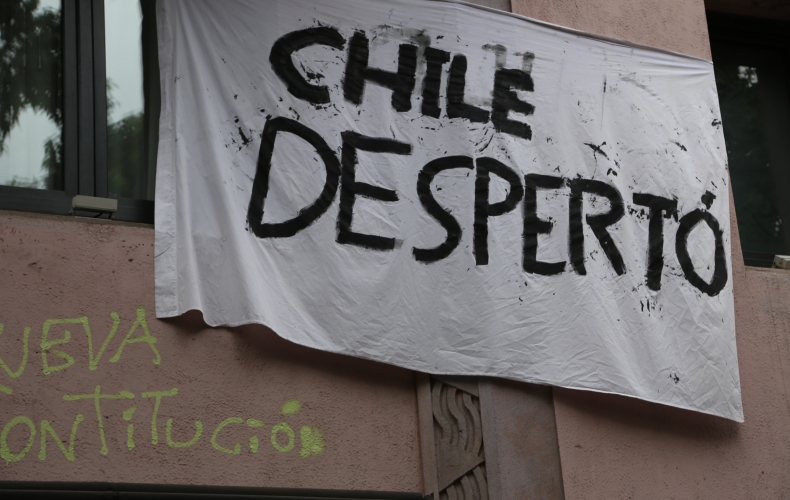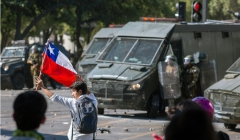Under the slogan “Chile despertó” (Chile woke up) the popular revolt of October 2019 changed the social landscape of the country. It was followed by months of massive demonstrations, which Piñera’s second administration tried to repress in order to reposition itself. COVID-19 hit Chile in early March as civil society prepared for the referendum to vote for a new constitution. The health crisis has rendered the precarious working conditions of the population visible. With the lowest budget for culture in Latin America, the cultural sector in Chile has taken a hard blow.
A powerful enemy
The popular revolt was initiated by students on the 18th of October 2019, after a rise in public transport fares. From this a massive social movement unfolded, which questioned the government’s strong commitment to the neoliberal economic model and the growing inequalities that it has created in Chile. As the movement grew, President Piñera declared “war against a powerful enemy”, namely the people of Chile, and the major cities, regional capitals and Mapuche communities in the south were intervened with military and police. After a curfew imposed by authorities the week after, theaters had to change schedules, festivals, art fairs, book fairs and concerts were cancelled. Student and cultural workers’ unions went on strike. The social movement challenged the economic model implemented during the military regime and consolidated over the three decades that followed, which has privatized healthcare, education, the pension system and contributed to the precarization of labor.
Assemblies were organized, and the associations aligned themselves with the popular demands for dignity, declaring that there would be no dialogue with the Ministry of Culture
The growing social organization by civil society, whose joint demand was dignity, was active in territorial assemblies and grassroots organizations, coming together under the imperative constitution building process. By the end of the year, museums, theaters and exhibition spaces had temporarily shut down, followed by months of uncertainty and police repression. However, the social movement had given way to other artistic expressions in the streets that supported the movement: posters, graffiti, performances, concerts and interventions started taking back public space as a political expression.
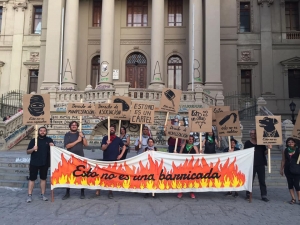
Artists’ associations such as Sidarte (the Actors’ Union), Apech (the Association of Painters and Sculptors), ACA (the Contemporary Art Association), PAV (Visual Arts Platform), RACH (the Network of Actresses of Chile) and UNA (the National Artists’ Union1) summoned artists and cultural agents to discuss the working conditions of the cultural sector and make them visible. Most of those who work in it are informal and/or intermittent workers and not eligible for social protection. Labor issues, as well as the role of culture in the constitutional process were put into perspective by the new scenario. Assemblies were organized, and the associations aligned themselves with the popular demands for dignity, declaring that there would be no dialogue with the Ministry of Culture – the government’s interlocutor with culture and the arts – until the violations of human rights committed since October 2019 were acknowledged by the government. By the beginning of 2020 the income of artists and cultural workers, most of whom are freelancers, had suffered, as institutions and cultural agents were trying to find a way to stay afloat.
During the summer (January, February 2020), Piñera adopted a new strategy: while police repression and persecution of activists intensified, the official discourse spoke about going back to normality, as a way to minimize the movement. But people were already organizing the comeback of massive demonstrations and strikes in March, which kicked off with International Women’s Day, that gathered 2 million women in the streets of Santiago and many more in the rest of the country.
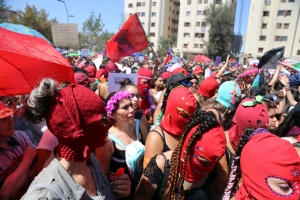
The pandemic
The first official case of COVID-19 in Chile was recorded on the 3rd of March and a week later the authorities announced sanitary recommendations, as the number of cases escalated. With a historically low 6% approval, Piñera’s government had lost all credibility and many anticipated that the government would weaponize the pandemic in order to further repress the social movement. In fact, one of the first measures was to declare curfew in the whole country for three months, which meant that the military were back on the streets. However, lockdown was applied partially and it seemed that the government was prioritizing the economy over people’s lives.
Thousands of artists and cultural agents from the performing arts, visual arts and crafts will have no income for an uncertain amount of time.
The situation of cultural workers is part of a bigger problem that affects all freelancers and informal workers within the context of the crisis. The unemployment rate has escalated to 15% in Santiago and it is expected to reach 18%, the highest since 1982. Without welfare policies in place, an emergency budget has been approved by the senate to provide meagre economic support, a bonus for a percentage of low income households, which is insufficient and has arrived too late.2 A legislative initiative to support freelance workers (not only cultural workers) with a credit (650,000 pesos for 3 months, to be paid in 2022) has been approved, but cultural workers have no capacity to get into debt.
With the inevitable lockdown brought on by the spread of the virus, cultural workers are losing their sources of income. All events such as festivals, book fairs and concerts have been cancelled, as well as educational programs and workshops. Theaters, art galleries and museums remain closed. Thousands of artists and cultural agents from the performing arts, visual arts and crafts will have no income for an uncertain amount of time.
A catastrophic situation
The health crisis renders visible the fact that most cultural workers have no stable income and have to support themselves with various kinds of informal work. In order to determine the current situation of artists and cultural workers, different associations created on-line surveys. The results show that, even before the health crisis, the sector had a high level of precarization and nearly 50% worked informally and without a contract. In the music sector, the average income from music is barely 50% of minimum wage, 301,000 pesos (367 USD). In the visual arts 84,4% have lost their source of income due to COVID-19, according to PAV4 (Visual Arts Platform). The situation is catastrophic.5
In Chile, while the contribution of the cultural sector to the economy is 2,2% of the GDP, the national budget for culture is only 0,4%. So what is the commitment from the State to arts and culture?
“this virus that separates us physically has renewed our collective spirit and the protest from another standpoint”
The health crisis has affected a sector of the economy (culture) that generates income and is a source of employment for thousands of people – declares UNA (National Artists’ Union). On March 17th, some of the artists unions made a proposal of emergency measures: an anticipated tax return, no tax discount for the (private, obligatory) pension system, to postpone financial reports from current grants, a special rescue bonus and the reallocation of funds that would not be used during the crisis.
Playwright Nona Fernandez made a plea to support culture. She wrote about the situation of the performing arts: “…we have been one of the first professions to align. We have left the stages, classes, workshops, recording studios. Freelancers have always had to deal with unemployment, old age, illness on their own and now with a pandemic. If we were not coming from a revolt, we would probably obediently lock ourselves down and maul our anguish and our failure, as always, but it is curious that this virus that separates us physically has renewed our collective spirit and the protest from another standpoint.”6
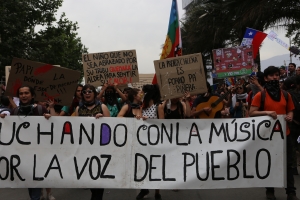
The government’s response
By the end of March, the Ministry of Cultures announced that 15,000 million pesos (19 million USD) will be allocated as a measure to support cultural workers, “for the acquisition of cultural content (such as copyright), for the promotion of artistic creation and to protect spaces and cultural organizations affected by the contingency”.7 The amount is to be reassigned from other programs and instruments within the ministry’s current budget, meaning that other programs will get budget cuts.
The associations have demanded transparency in the mechanisms for the distribution of the funds
The measure has been received with ambivalence because of the existing mistrust in the government, opening up a public debate that has made apparent the precarious working conditions of cultural workers throughout the country. The associations have demanded transparency in the mechanisms for the distribution of the funds and a long-term vision to provide more economic stability for cultural workers in the future.
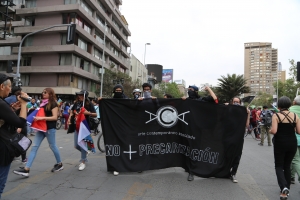
Alarming numbers
A survey of cultural agents and organizations has been launched within the government action plan to respond to the health crisis: “Due to the health emergency produced by the outbreak of coronavirus, as the Ministry of Cultures, Arts and Heritage we have designed a public online survey to develop a registry of the working conditions and economic situation of cultural agents and organizations”. The results from the survey, answered by 15,079 cultural agents from all over the country, were published in early May. It includes artists from all sectors, such as music, performing arts, visual arts, artistic education, cultural management, crafts and film. The survey reveals alarming numbers: 85% work free-lance and 70% work without any kind of contract, 79,4% have no stable income, 20% have no health insurance. In regards to their current economic situation, 72,3% describe it as bad, while 48% expect that in one year it will be worse. The survey also gives an account of the cancellation of upcoming shows, teaching, exhibitions, tours and sales due to COVID-19, a situation that is already affecting the workers, and how it will decrease their income even more.
70% work without any kind of contract, 79,4% have no stable income, 20% have no health insurance
On the same day, a member of parliament from the right-wing party UDI, questioned the minister and demanded to spend the 15,000 million pesos on health. He added, with suspicion: “If you will give resources to artists, a well defined criteria must be established, along with a detailed mechanism of how the funds would be assigned, so that it does not turn into an indiscriminate payout among the usual ones”. This declaration triggered a controversy in the social media against the measure, along with the hashtag #noAlos15milmillones (no to the 15,000 million) and several offensive tweets blaming the cultural sector for supporting acts of violence against the government during the popular revolt. According to actress Andrea Gutierrez from RACH, the hashtag comes from “the concerted and opportunist right that tries to trend in the social media as vengeance for the critical position that the cultural world has had towards this government and the violation of human rights that we have lived through.”9
UNA has asked for an explanation on how the funds will be distributed, while Sidarte has stated that it was expected that the Ministry includes the cultural sector in the conversation before making such decisions. The Minister of Culture, Consuelo Valdés clarified: “I am referring to funds and resources that exist in this year’s budget. There are no new resources being injected from other public funds”.10
public funding policies can no longer be implemented through competitions, because of the instability this creates
Meanwhile, the president of the culture commission of the senate has proposed some concrete measures: to return 100% of income tax for freelancers, to postpone tax payment for theater companies and institutions linked to the cultural sector and that the Ministry of Culture speeds up the payments of projects that will be executed in 2020. In addition, organizations from the performing arts have demanded that a participatory “technical working group” be implemented, to draw up a COVID-19 contingency plan to alleviate the financial situation of the sector, including the anticipated tax return, a basic food basket and health insurance. UNA has organized a meeting with the culture commission of the parliament, inviting the Ministers of Culture, Social Development and Treasury to discuss the situation of the sector, but none of them attended.
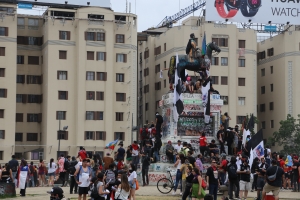
Nélida Pozo, director of Parque Cultural de Valparaíso, writes that “in a country with a newly created ministry whose budget lies at around 0,4% of the national budget – one of the lowest in Latin America – it is not strange that we have such a harsh crisis, whose dimension we are still not able to acknowledge”. In her view, public funding policies can no longer be implemented through competitions, because of the instability this creates, the impossibility of artists to think of long-term projects that make their work, because of the stress and the lack of a collective aspect embedded in the logic of competition.11
Culture in agony
By the end of April, the government’s actions to aid the cultural sector were finally published: acquisition of cultural content, grants for production and tours, capacity building in e-commerce. There will also be a grant for “spaces with cultural programming”, all of the above by open call. The timeframes fall into the second half of the year, and the evaluation process will take months. “We have to understand that the state is subject to administrative procedures that aim for transparency and objectivity in the distribution of the resources, and has to abide by the legality of expenditures. The Ministry cannot give away resources such as social bonuses, but has to allocate them in relation to projects, to specific beneficiaries that have to account for those projects”says Juan Carlos Silva, undersecretary of Culture. This is confirmed by Emilio de la Cerda, undersecretary of Heritage, who adds “There is will and decision to support, but the Ministry has no legal faculty to give direct subsidies”. This means that the 15,000 million will not be allocated in connection to the alarming results of their survey, because they will be distributed without giving priority to those cultural agents who have lost their income.
“Would you compete for help during a state of health crisis?”
“Our work is not valued,”says Daniela Espinoza from SINTECI (Union of Film and Audiovisual Professionals and Technicians), “they are asking us to ‘reinvent’ ourselves, instead of giving us support.”
“Would you compete for help during a state of health crisis?” the UNA wrote in social media in response to the announcements. “Culture is in agony today, we need concrete actions, real dialogue with the ministry and political will”. With the hashtags #nosonfondosdeemergencia (they are not emergency funds) and #culturaenagonía (culture in agony) the artists associations protest against the government’s measures. Neither the survey nor the demands from the workers have been taken into account.
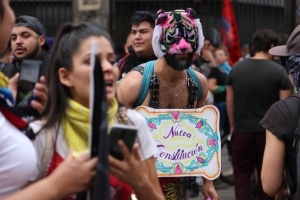
Given the progress of the pandemic and the lack of solutions, artists have taken action and some campaigns are in place, like the one initiated by PAV based on donations, to distribute (75–125 USD each) to those visual artists who are facing extreme situations. Or CEAC (theater of the University of Chile) who has launched a donation campaign for their stable ensemble and troupe. But none of this will be enough to sustain the sector.
how urgent it is to politicize art-related practices by self-organizing and imagining ways to come together
The Ministry of Culture, Arts and Heritage (the former National Arts Council), a structure inherited from the previous administration, has had an erratic start with three different ministers in two years during Piñera’s term of office. It has not been able to face the challenges of cultural producers in Chile, it has not consolidated a sufficient budget and it continues to make its only policy to outsource cultural content. Not only artists, performing arts companies and cultural organizations have to compete for funds, but also public institutions like museums and theaters fill their programming with projects funded by open calls.
Collective strength
Art critic Diego Parra discusses the situation of cultural workers in regards to the historical splintering of the sector. He writes that a solution can only arrive if multiple agents that make up the sector are able to associate in a way that ensures that neither the state nor the private world can continue to take advantage of a mass of workers that, on one hand, do not know their rights and on the other, have not had the collective strength to unionize. He points out how urgent it is to politicize art-related practices by self-organizing and imagining ways to come together.12
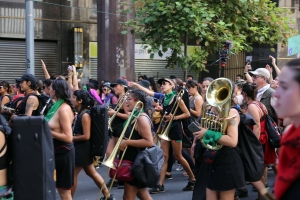
In a pandemic, an infectious disease has extended to large geographical regions and the whole population is considered potentially infected, so the conditions for public health measures and healthcare must be made available. However, in Chile a large percentage of the population works without social protection and cannot “stay home” while keeping food on the table. Piñera’s management of the crisis has prioritized the well-being of corporations over people and civil society is going through confinement in total darkness, distrustful of the government and misinformed by the media. After months of demonstrating and marching together, COVID-19 has arrived in Chile and people are confined and physically apart, and the contrast has been overwhelming. The month of May has arrived with new revolts against the government because people have started to go hungry. Oblivious to criticism, Piñera insists on a “sanitizing” strategy: by painting over the graffiti of empty cities, he wants to erase the conscience gained by the popular awakening of October. But the crisis triggered by COVID 19 exposes, even more, the indelible social inequalities. It reassures the urgent demands for dignity and the need for a new participatory constitution making process.
Massive unemployment and social vulnerability paints a sombre landscape for the coming months in Chile. Without real emergency funds, the cultural sector will suffer. It is not clear how the social movements will reconfigure after lockdown, but what this crisis has shown for cultural workers is the need to renew their collective efforts, politicize their practices and strengthen their own networks, in order to make the demands of the sector part of the priorities of the Ministry of Culture and to play a role in proposing structural changes in the future constitutional process.
Agnes Evseev is a sound explorer, thereminist, free improviser and director of Electromagnetica – Chilean International Theremin Festival.
Claudia Del Fierro is a visual artist who works in a variety of media, including video, performance and installation. She has developed her work in South America and Europe, has participated in Mercosul Bienal, Havanna Bienal and a number of collective and individual exhibitions in Europe and Latin America. Del Fierro has been a recipient of grants from the National Chilean Council for Arts and Culture and Konstnärsnämnden, among others.
This article is published in collaboration with an art auction initiative that took place in Stockholm December 2019 in solidarity with the Chilean people. The initiative engaged 121 visual artist in Sweden and was organized by Macarena Dusant, Mariana Silva Varela and Paola Zamora. Visit @chile18_21 for more information.
Top image: Demonstration at Plaza de la Dignidad, Santiago, November 8th, 2019. Photo: Claudia Del Fierro.
Footnotes
- Unión Nacional de Artistas, an umbrella association for several unions, that represents all artistic disciplines working for arts and culture.
- Ingreso Familiar de Emergencia (emergency family income) consists of 3 bonuses per household. After a debate in parliament the amount has now been raised to 100,000 pesos. The measure was announced to reach 500,000 low income households in the country but has proven to reach less. A COVID bonus has been announced of 50,000 pesos (64 USD) per capita for a segment of the population with low income.
- https://drive.google.com/file/d/11KtSddRdMqPwtYA4KJOLOI_GgN1y4yeW/view
- A survey by Gestoras en Red (women workers in arts and culture) answered by 1000 women in 2019, reveals that 48% of women in arts and culture work without a contract, 28% have a temporary contract without benefits, 14% have an indefinite contract, 10% invoice per task and 67% of them work exclusively in culture. According to ODMC (Digital Music Observatory), in a survey applied to 2284 persons in the music sector, 56% have a second source of income in order to survive. In 66% of the cases, the income from music generates no more than 2,000,000 pesos (2.500 USD) a year. Only 16% is working on projects with some sort of state funding.A survey made by PAV, answered by 420 visual artists in March 2020, reveals that 33,7% works informally and 59,3% of homes receive an income below 501,000 pesos (620 USD) per month. 84,8% of visual artists have lost their sources of income due to the health crisis and 72,9% will not be able to support their basic needs. See www.gestorasenred.com
- www.elmostrador.cl/cultura/2020/03/19/la-marcha-del-boletariado/
- www.cultura.gob.cl/institucional/ministerio-de-las-culturas-las-artes-y-el-patrimonio-destinara-15-mil-millones-de-pesos-para-apoyar-a-artistas-y-organizaciones-ante-emergencia-por-coronavirus/
- http://observatorio.cultura.gob.cl/wp-content/uploads/2020/04/Catrastro-COVID-19.pdf
- www.elperiodista.cl/la-falacia-de-los-15-mil-millones/
- https://radio.uchile.cl/2020/03/26/artistas-exigen-al-ministerio-de-las-culturas-retroceder-en-su-plan-para-amortiguar-crisis-del-sector/
- www.eldesconcierto.cl/2020/03/30/cultura-las-vulnerabilidades-de-un-sector-precarizado/
- www.eldesconcierto.cl/libros/la-critica-situacion-de-los-trabajadores-del-arte-y-la-ayuda-estatal-cuando/

